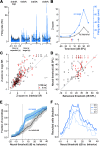Behaviorally gated reduction of spontaneous discharge can improve detection thresholds in auditory cortex
- PMID: 24623785
- PMCID: PMC3951702
- DOI: 10.1523/JNEUROSCI.4825-13.2014
Behaviorally gated reduction of spontaneous discharge can improve detection thresholds in auditory cortex
Abstract
Animals often listen selectively for particular sounds, a strategy that could alter neural encoding mechanisms to maximize the ability to detect the target. Here, we recorded auditory cortex neuron responses in well trained, freely moving gerbils as they performed a tone detection task. Each trial was initiated by the animal, providing a predictable time window during which to listen. No sound was presented on nogo trials, permitting us to assess spontaneous activity on trials in which a signal could have been expected, but was not delivered. Immediately after animals initiated a trial, auditory cortex neurons displayed a 26% reduction in spontaneous activity. Moreover, when stimulus-driven discharge rate was referenced to this reduced baseline, a larger fraction of auditory cortex neurons displayed a detection threshold within 10 dB of the behavioral threshold. These findings suggest that auditory cortex spontaneous discharge rate can be modulated transiently during task performance, thereby increasing the signal-to-noise ratio and enhancing signal detection.
Keywords: attention; auditory cortex; auditory perception; detection threshold; expectation; spontaneous activity.
Figures




References
Publication types
MeSH terms
Grants and funding
LinkOut - more resources
Full Text Sources
Other Literature Sources
Miscellaneous
